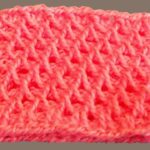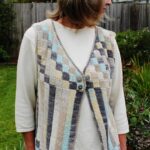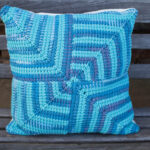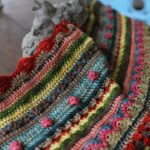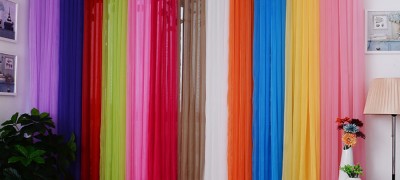Blankets and other things Tunisian knitting
Tunisian knitting is a special kind of needlework that combines knitting and crocheting techniques. This type of knitting requires a special crochet hook, which is much longer than usual. The material from such knitting turns out to be denser, does not stretch and does not deform after washing. This method is well suited for making cardigans, baby clothes. Blankets with Tunisian knitting are especially beautiful, since these products, due to their high density, warm well.
What is Tunisian Crochet
Tunisian knitting is different from other ways of working with yarn. It is because of the originality of the method that many craftswomen want to try it. Unlike classic crochet, this type of crochet places all the loops on the hook, which requires longer tools.

In this case, the product is not turned over, but moves alternately in different directions. In this case, the canvas turns out to be more rigid, because of which it can even curl slightly. After creation, it is recommended to steam the item to give it a better shape.
What kind of hook is needed
This knitting technique will require special tools:
- Long hook. Its length is from 20 cm. It is needed for knitting fabrics of medium and small width.
- Hook with line. It looks like a circular knitting needle, but there is a plug at one end of the line, and a hook at the other. The line can be quite long. This makes it possible to create very wide products, such as rugs.
- Double hook. It can be single with heads on both sides, or it can consist of two halves connected by knitting needles.
Tools are made from different materials: wood, plastic or metal. The most convenient are aluminum fixtures, which have a special coating. The yarn glides well on such a tool, it is easy to grasp, and the loops are easy to move.
Advice. For beginners, it is better to purchase a whole set of tools at once. This will allow you to try tools of different thicknesses and designs and choose the most suitable option for yourself.
Yarn
The yarn should be thinner than normal knitting. Otherwise, the canvas will be too thick and dense. This will make it look ugly, it will curl more.
It is believed that when knitting with a regular crochet, the yarn consumption is slightly higher than when using knitting needles. With the Tunisian method, despite the high density of the fabric, the yarn consumption is reduced by 20-25%.

The yarn for this technique can be any: woolen, cotton. Since the product is slightly deformed, even complex types of yarn are suitable for this knitting: viscose or bamboo. These types have slippery threads, so it is rather difficult to work with them with knitting needles, since the knitting can turn out to be uneven. Knitted with this yarn can be deformed and unevenly crocheted. With Tunisian knitting, this is excluded.
However, coarse or dense yarns must be selected with care, as the garment may become too coarse.
Advice.In order to correctly calculate the yarn consumption, as well as to estimate the density of the fabric, it is important to first tie the sample. It, as a rule, is knitted at the rate of 10 by 10 cm. For this piece, it is easy to calculate the number of loops, and hence the amount of yarn.
Knitting technique
In Tunisian knitting, all work is done only on the front side. Moreover, each row of loops actually consists of two. First, loops from the previous row are knitted from right to left. Then, from left to right, the loops are fixed. After that, the next stage begins. Any work, just like with the classical crochet technique, begins with a chain of air loops. At the end, the knitting is fixed with single crochet columns.

There are three basic techniques in Tunisian knitting. They vary in complexity.
The easy way
This technique is classic, it is also called the direct method. Step-by-step instruction:
- A chain of air loops is created.
- Without turning the product over, loops from the chain are crocheted. You do not need to tie them. They stay hooked.
- The movement begins from left to right when fastening the loops. The crochet grabs the thread and passes it through the last two loops. Then the process is repeated.
- From here, loops are typed from right to left. Then they are fixed in a similar way.
- At the end of each row, you need to do 1 VP to raise the knitting. This will create a nice, even edge.

Front surface
This method creates a denser fabric that looks like a regular knitting pattern.
Step-by-step instruction:
- A chain of air loops is created. The first two rows are knitted in a straight way.
- When creating the next row, the hook is inserted into the middle of the previous column, the thread is pulled from the seamy side and comes out from the front. Thus, glad loops are typed.
- In the opposite direction, the loops are knitted in the same way as usual - 2 loops each.
Twisted knit
This method also produces a tighter knit with an interesting, embossed pattern.
Step-by-step instructions:
- The first two rows are done in the usual way.
- In the next step, the loops will be twisted. To do this, when sewing a loop, the hook turns in the opposite direction from left to right. When the thread is pulled out, the loop unfolds in the opposite direction and a twist is obtained.
- Loops are fastened in the usual way.
The use of Tunisian techniques
Due to its simplicity and good quality of the canvas, this technique is becoming more popular. It is used not only for clothing, but also for interior items. Tunisian crochet is used for blankets, pillows, bedspreads with different patterns.
For a blanket
Beginners can be advised to create a blanket. Its scheme is very simple: a canvas with a width of 1.5X1 meters is created. To do this, you need to choose a tool with a long line and thick yarn of three colors: 800 g each turquoise and blue and 400 g light blue.
Stages of work:
- Two-tone squares are knitted. First you need to make a chain of 31 air loops. The height of each square is 25 rows. In total, you need to tie 8 squares.
- The two-color effect is achieved in the following way: 1 row is knitted from blue yarn, 2 rows from blue, then again 1 row of their blue, 2 rows of blue. You will get a beautiful, melange effect.
- Squares with knobs are knitted from turquoise yarn. To do this, create a chain of 31 stitches and knit 25 rows. Bumps are tied in the middle of the squares. They are knitted using lush columns: 1 yarn, then 1 loop is pulled through the loop of the previous row, then again the yarn and another one is pulled out of the same loop, and the process is repeated. After that, three crochet stitches are knitted together again. In total, you need to create 7 squares.
- After that, the squares are connected to each other using half-columns. The blanket is ready.
Pillow
Tunisian knitting works well for pillows. Round pillows look especially impressive.
Stages of work:
- A chain of air loops is typed, the size of the radius of the future pillow.
- The 3rd and 4th loops of the chain are knitted.
- The hinges are fixed.
- From the previous row, 4 loops are tied in a direct course. The hinges are fixed.
- Then the process is repeated, each time the number of raised loops increases. This creates a segment of a circle. In total, 12 segments need to be made - 6 for one side and 6 for the other. They can be of different colors.
- After that, the segments are connected to each other in two circles. The circles, in turn, also connect to each other.
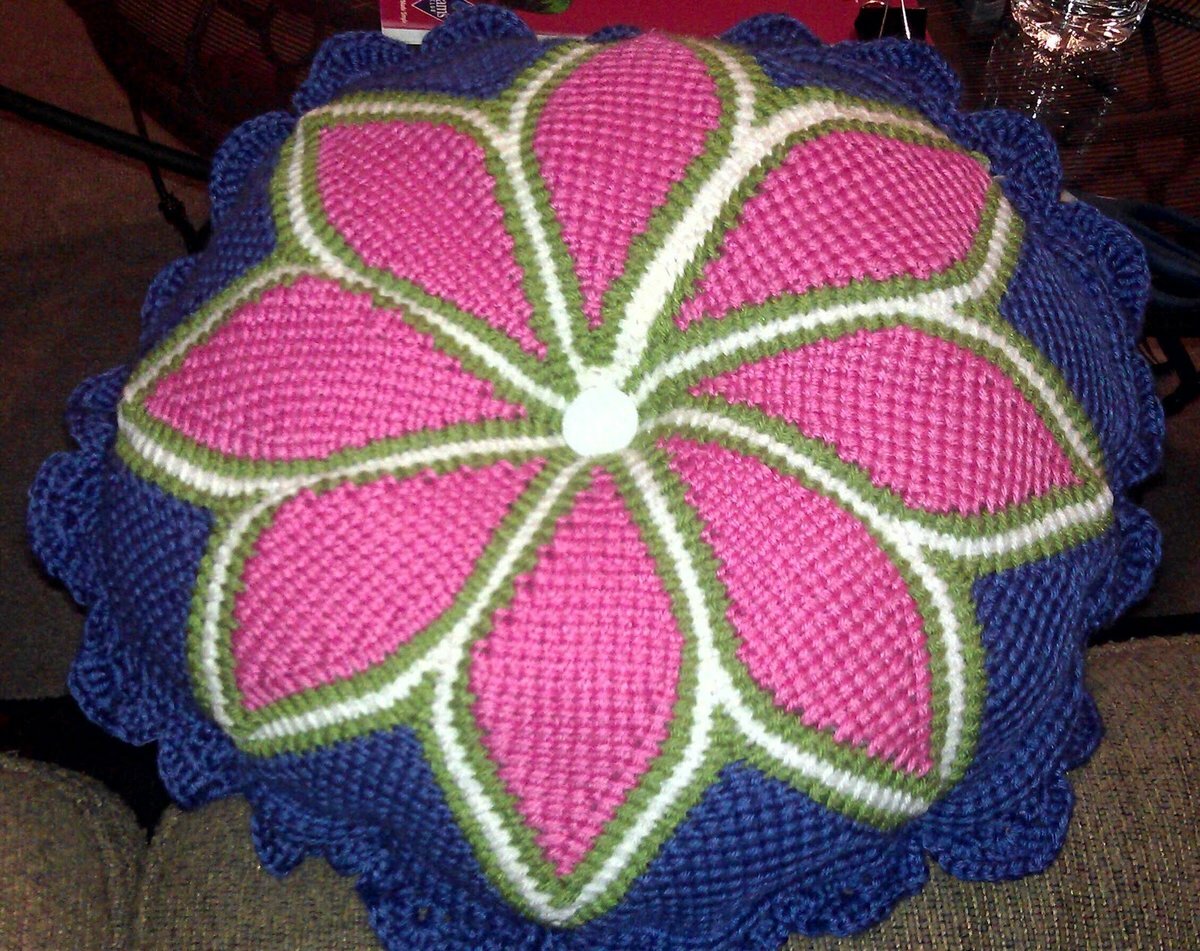
Cover
The blanket must be knitted on needles with a long fishing line. This will allow you to make a single canvas. You can also knit it from squares of different sizes.

The bedspread will look beautiful if knitted from yarn of two colors. When alternating colors, every two rows will get a beautiful cell pattern. To do this, the second thread is pulled behind the main loops.

Because of this, the knitting will be tighter, which is necessary in order to cover the furniture.
White roses
Since the products in this technique keep their shape well, it is convenient to use it for making flowers, for example, white roses.
Stages of work:
- Flowers are created first. To do this, you need to make a small chain of air loops, close it in a circle.
- Knit several rows in a circle. On each row, doubling the number of loops.
- Starting from the 6th row, petals are individually knitted.
- When all the petals are created, the flower must be tied with a number of half-columns and a thin wire woven into it.
- After that, small circles of yellow yarn are created. They will become the heart of the flower.
- The leaves are knitted separately. First, a chain is created, which will become the center of the leaf. Then each half of the leaf is tied. The number of stitches decreases on both edges in each row.
- At the end, all the details of the bouquet are connected.
Pros and cons of this technique
This technique has its advantages and disadvantages. Using this technique, you can create a canvas of any shape: rectangular, round or special, non-standard shapes. Due to the uniqueness of this method, it is ideal for any type of clothing and accessories.
It makes good bags, cosmetic bags, wallets. Tunisian knitted scarves and blankets will keep warm well. Cardigans and sweaters will keep their shape for a long time and will not stretch.

Products will not deform in the future. Therefore, this method is suitable for creating complex shapes.
In Tunisian knitting, it is easy to create multi-colored patterns and even a whole jacquard fabric. Some products are additionally decorated with embroidery or embroidered with beads. Due to the density of the canvas, such decorations hold well on it.
The disadvantage of this method is the low elasticity of the canvas. Therefore, if it is necessary to create tight-fitting things, objects that should be stretched, then this technique will not work.

Scheme designation
The symbols in the Tunisian method charts are similar to those for regular crochet, but some of the icons may differ:
- VP - air loops. The creation of any product begins with them.
- SP - a column of a straight row.
- TS - Tunisian column. This is the same as the SP. But this designation is found only in this method.
- PS - half-column. They can fasten loops. Also used for joining products.
- RLS - single crochet. Always finishes the product. In the canvas, it is used to create higher loops.
- ЗП - closing loop.This icon is only found in Tunisian knitting patterns.
- STS - twisted TS or twisted Tunisian column.
Thanks to the patterns and your own imagination, it is not difficult to master this type of knitting. And you can make a great variety of interesting products with it.
Video: Tunisian crochet technique








